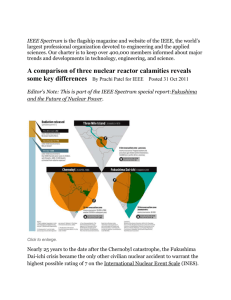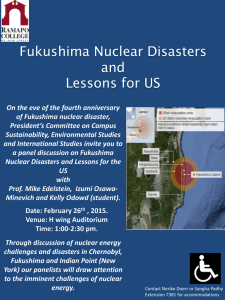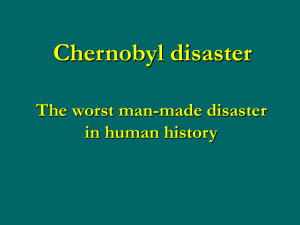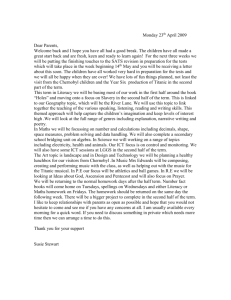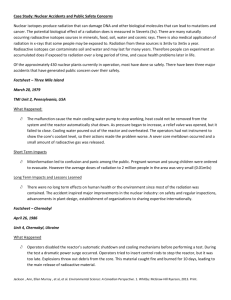Bioremediation: Absorbing the Damage of Disasters
advertisement
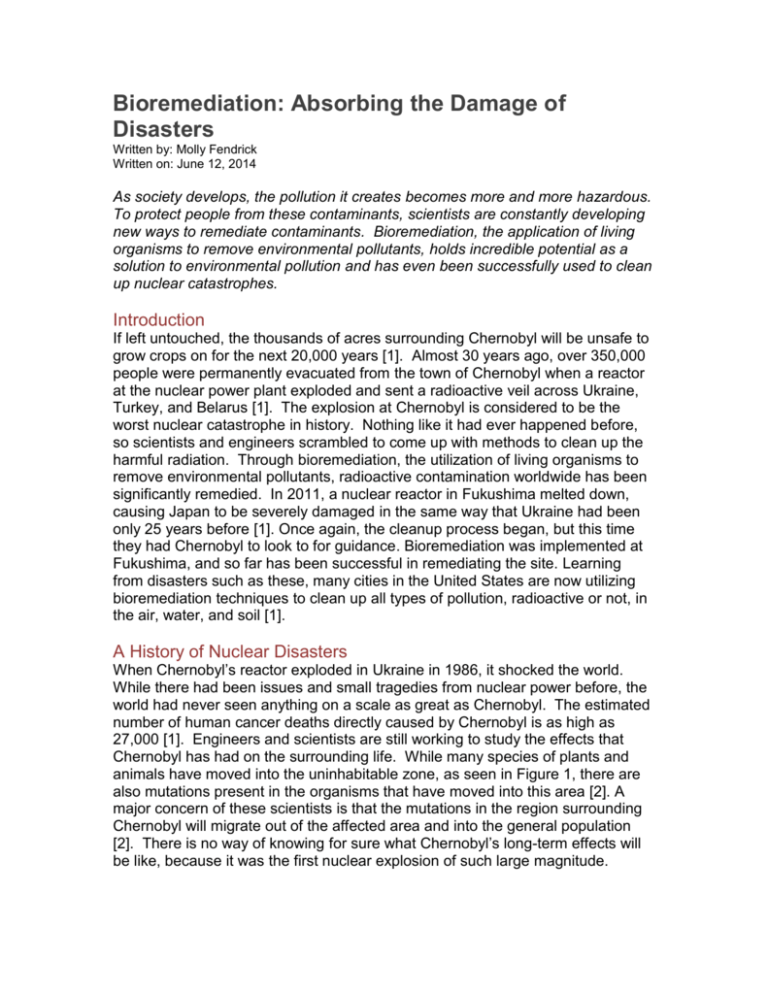
Bioremediation: Absorbing the Damage of Disasters Written by: Molly Fendrick Written on: June 12, 2014 As society develops, the pollution it creates becomes more and more hazardous. To protect people from these contaminants, scientists are constantly developing new ways to remediate contaminants. Bioremediation, the application of living organisms to remove environmental pollutants, holds incredible potential as a solution to environmental pollution and has even been successfully used to clean up nuclear catastrophes. Introduction If left untouched, the thousands of acres surrounding Chernobyl will be unsafe to grow crops on for the next 20,000 years [1]. Almost 30 years ago, over 350,000 people were permanently evacuated from the town of Chernobyl when a reactor at the nuclear power plant exploded and sent a radioactive veil across Ukraine, Turkey, and Belarus [1]. The explosion at Chernobyl is considered to be the worst nuclear catastrophe in history. Nothing like it had ever happened before, so scientists and engineers scrambled to come up with methods to clean up the harmful radiation. Through bioremediation, the utilization of living organisms to remove environmental pollutants, radioactive contamination worldwide has been significantly remedied. In 2011, a nuclear reactor in Fukushima melted down, causing Japan to be severely damaged in the same way that Ukraine had been only 25 years before [1]. Once again, the cleanup process began, but this time they had Chernobyl to look to for guidance. Bioremediation was implemented at Fukushima, and so far has been successful in remediating the site. Learning from disasters such as these, many cities in the United States are now utilizing bioremediation techniques to clean up all types of pollution, radioactive or not, in the air, water, and soil [1]. A History of Nuclear Disasters When Chernobyl’s reactor exploded in Ukraine in 1986, it shocked the world. While there had been issues and small tragedies from nuclear power before, the world had never seen anything on a scale as great as Chernobyl. The estimated number of human cancer deaths directly caused by Chernobyl is as high as 27,000 [1]. Engineers and scientists are still working to study the effects that Chernobyl has had on the surrounding life. While many species of plants and animals have moved into the uninhabitable zone, as seen in Figure 1, there are also mutations present in the organisms that have moved into this area [2]. A major concern of these scientists is that the mutations in the region surrounding Chernobyl will migrate out of the affected area and into the general population [2]. There is no way of knowing for sure what Chernobyl’s long-term effects will be like, because it was the first nuclear explosion of such large magnitude. Similar accidents since then have had the slight advantage of being able to look to and learn from the cleanup at Chernobyl. Figure 1. A wolf within the uninhabitable area surrounding Chernobyl [3] More recently, in Fukushima, Japan, several reactor cores at a nuclear power plant partially melted in March 2011 when they were damaged by an earthquake and the subsequent tsunami [4]. Not only did this cause over 160,000 residents to be removed from the area, but it also constituted the largest discharge of radioactive material into the ocean in history. Areas surrounding the power plant are now unable to sell agricultural crops, and fishing is not allowed within the waters adjacent to the meltdown, completely devastating the productivity of this area [4]. The people of Japan, as well as the rest of the world, will be recovering from such a devastating accident for centuries to come. They look to the cleanup of Chernobyl to understand what the lasting effects will be, but it can be difficult to predict what radioactive sites will look like in the future. In the United States, Bikini Atoll is still uninhabitable, 70 years after nuclear testing was done there [5]. Watching the effects of radiation on animals can help show how humans may be affected in the long run, but because most animals live shorter lives than humans, it takes longer to see how the radiation from such disasters affects humans genetically [6]. The effects of these tragedies will be evident for centuries, left for future generations to continue to manage. Cleaning up a radioactive site is not just one that includes the immediate responders. For generations, the people of these areas will be tasked with cleaning up and containing the radioactive pollutants as well as the structures that housed them. The main contaminant released by nuclear accidents, radioactive cesium, has a half-life of 30 years [4]. All radioactive contaminants take about 10 half-lives to disappear enough for an area to be considered safe [4]. Nearly 2 million acres of land around Chernobyl has been permanently damaged by radiation [7]. In Fukushima, thousands of acres have been infected with radiation, and it is continually being spread by melting snow and rainwater [4]. Scientists are rushing to diminish the levels of contamination in these expanses to minimize the spread of radiation to the rest of the world. Recovering Chernobyl and Fukushima In order to minimize contamination in radioactive disaster zones, many different methods of cleanup have been engineered to remove radionuclides as quickly as possible. Bioremediation, the application of living organisms to remove environmental pollutants, has proven to be a quick, inexpensive, and efficient method of removing radioactive pollutants [8]. There are two common types of bioremediation currently utilized: phytoremediation, the use of plants to clean up radionuclides, and mycoremediation, the use of fungi. Bacteria can also be used to remediate pollutants, although their use has not yet been documented at any large nuclear disaster sites [8]. Phytoremediation, as graphically shown in Figure 2, has been well documented as a useful method for decontaminating the land and water around Chernobyl. Plants such as sunflowers and Indian mustard have been planted there, and eagerly absorb cesium and strontium, pulling it out of the ground and into their stalks and leaves [10]. These two elements have radioactive isotopes which are emitted by nuclear reactors, and when they are released into the environment they often lead to cancer in humans and animals. The removal of these isotopes is important in minimizing the amount of time that an area is uninhabitable after a nuclear disaster. Mycoremediation through the use of mushrooms has also proven to be a quick method of removing radionuclides, especially cesium, and it has been proposed as a method of cleaning up Fukushima. Once these plants and fungi have absorbed the radionuclides, they are removed and incinerated, and replaced with new plants that will continue to soak up radiation from the ground [10]. Figure 2. A simplified illustration of phytoremediation [9] At Chernobyl, sunflowers were planted onto rafts, allowing their roots to hang down, and placed into contaminated water [11]. They were able to successfully soak up nearly all of the radioactive cesium in the water in about three weeks. In the three years since Fukushima’s explosion, people have begun to plant sunflowers in hopes that it will reduce the radioactivity levels in a similar way, as seen in Figure 3. [11]. It is not a perfect system, as the reach of these organisms is limited to the top few inches of the soil, and there are still harmful ashes to deal with after incineration of the radioactive plants. But it is still a much better option than leaving the radionuclides in the environment, and the hazardous ash is easily and safely stored away below ground [6]. Bioremediation continues to be refined and improved for use at these enormous accident sites, but has also proven useful for cleaning up numerous other types of contaminants at a variety of sites. Figure 3. Sunflowers planted at Fukushima [12] Remediation in the United States Across the globe from these tragedies, a dry cleaning plant in Houston is adopting the strategies used at nuclear contamination sites to remove harmful pollutants from the ground below [13]. By implementing bioremediation through bacteria, the chlorinated solvent concentrations in the groundwater beneath the business were reduced by 99 percent in less than 90 days. By law, dry cleaners in California will stop being allowed to produce chlorinated solvents within the next decade [13]. Even when they do stop producing these pollutants, there will still be all of the previous build up of harmful contaminants below these buildings. These chlorinated solvents are known carcinogens, and need to be removed from the soil as quickly as possible [13]. As seen at the Houston site, bioremediation is the quickest and easiest method of doing so, and can be applied to a wide range of locations. Even though the United States has not had a large-scale nuclear disaster, it still has the need to clean up nuclear waste. Hanford, located in Washington State, is the nation’s largest site of nuclear pollution [14]. For decades, plutonium for nuclear weapons was processed here. The factory has closed, but the government is now tasked with cleaning up the leftover radioactive waste. This waste is stored in 177 underground tanks, shown during construction in Figure 4. Some of these tanks are currently leaking, although fortunately it is a very lowactivity nuclear waste when compared to areas like Fukushima and Chernobyl. As federal negotiations and plans for cleaning up this site are developed, bioremediation is becoming considered as a leading option for removing the waste from the soils and groundwater [14]. Figure 4. The storage tanks at the Hanford Nuclear Reservation in Washington State [15] Of all of the nuclear power plants in the United States, Indian Point is thought to be the one at maximum risk of severe earthquake damage, similar to Fukushima [16]. Located 25 miles north of New York City, there has always been concern from the public about the safety of the plant. If it were to malfunction, 20 million people could potentially be displaced [16]. After the disaster at Fukushima, this plant, along with the 64 other nuclear power plants in the United States, has increased safety guidelines and inspections on reactors in order to maintain the safest functionality and prevent anything from malfunctioning [16]. The Future There is no way of knowing for sure how time will change the uninhabitable zones around Chernobyl and Fukushima, but as research and funding for bioremediation grows, it is at least known for certain that these organisms will continue to reduce the amount of radioactivity in these zones. Large-scale nuclear disasters will require cleanup for tens of thousands of years, and as we create new ways of remediating these areas, we will be able to scale these technologies down and apply them to an array of polluted sites across the globe. References [1] E. Harrell and J. Marson. (2011, Apr. 16). “Apocalypse Today: Visiting Chernobyl, 25 Years Later” [Online]. Available: www.time.com [2] K. Ravilious. (2006, Apr. 26). “Despite Mutations, Chernobyl Wildlife is Thriving” [Online]. Available: www.news.nationalgeographic.com [3] L. Helmuth. “Chernobyl’s Wildlife Survivors” [Online]. Available: www.slate.com [4] S. Starr. (2012). “Costs and Consequences of the Fukushima Daiichi Disaster” [Online]. Available: www.psr.org [5] “Conditions at Bikini Atoll” [Online]. (2013, Sep. 9). Available: www.ns.iaea.org [6] “Chernobyl and Fukushima Radiation Reduces Animal and Plant Numbers, Diversity, Lifespan, Fertility, Brain Size, Increases Deformities and Abnormalities” [Online]. (2014, Mar. 13). Available: www.globalresearch.ca [7] R. Maughan. (2013, Dec. 31). “Chernobyl Nuclear Disaster Site Becomes a Wildlife Area, including over a hundred wolves” [Online]. Available: www.thewildlifenews.com [8] I. Rakin, R.D. Smith, D.E. Salt. (1997). “Phytoremediation of Metals: Using Plants to Remove Pollutants from the Environment” [Online]. Available: www.ufv.br [9] P. Favas, J. Pratas, M. Varun, R. D’Souza, and M. Paul. (2014, Mar. 26). “Phytoremediation of Soils Contaminated with Metals and Metalloids at Mining Areas: Potential of Native Flora” [Online]. M. Hernandez Soriano, Ed. Available: www.intechopen.com/books [10] “Bioremediation for Contaminated Soil: Phytoremediation and Mycoremediation” [Online]. (2011, Jul. 16). Available: www.holisticradioprotection.wordpress.com [11] http://www.helladelicious.com/diy/2011/09/sunflowers-and-bacteria-clean-upradiation/ [12] S. McFadden. (2011, Jul. 21). “Sowing Seeds of Hope at Nuclear Disaster Site” [Online]. Available: www.thecalloftheland.wordpress.com [13] “Bioremediation Saves Dry Cleaners Hundreds of Thousands of Dollars” [Online]. (2014, Jan. 8). Available: www.environmentalleader.com [14] “Cleanup Plan for Hanford Nuclear Reservation Pushed by Frustrated Washington State Leaders” [Online]. (2014, Mar. 31). Available: www.oregonlive.com [15] “Leaking Underground Tanks at Hanford” [Online]. Available: www.ecy.wa.gov [16] W. Dizard. (2013, Oct. 14). “Fukushima on the Hudson: Could a Nuclear Accident Happen Near NYC?” [Online]. Available: www.fairewinds.org
